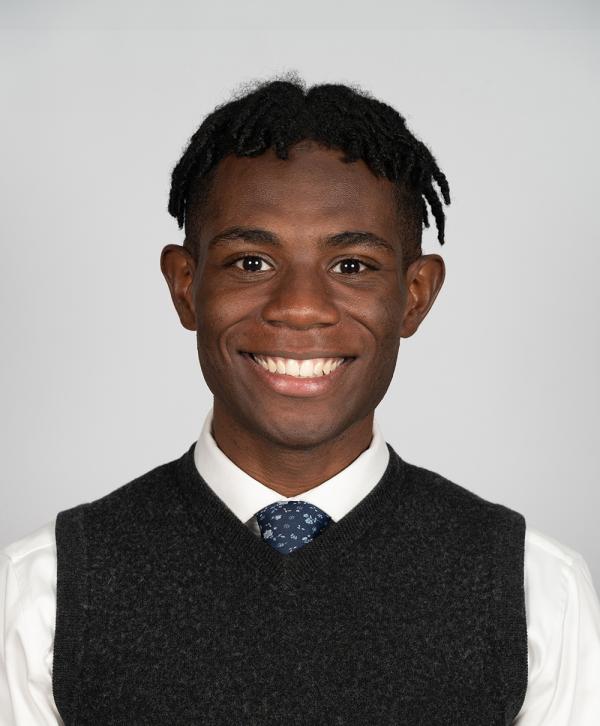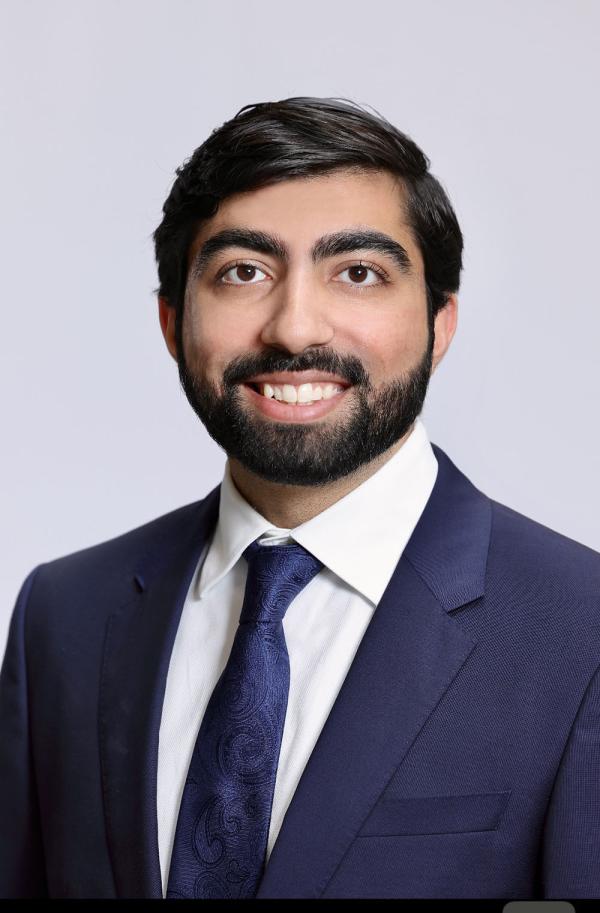The (Future) Doctor Is In
Medical Students Enjoy a Year at NIH
Every physician spends years in school getting trained to provide healthcare to patients with a wide array of health conditions, but not all of them know much about how the tools they use and the treatments they offer make it from the lab to the clinic. For the past year, 42 medical students took time off from their studies to fill in that gap first-hand by working in IRP labs as part of NIH’s Medical Research Scholars Program. As their stints at NIH wind down, each of them will return to medical school with valuable scientific training that will surely enhance their ability to help patients in the future. Keep reading to see how the MRSP has given a leg up to three of these bright future doctors.
Quashawn Chadwick: Analyzing Genes in an HIV-Associated Cancer

Quashawn is one of many physician-scientists who took a relatively circuitous path to the lab. His first love was actually music, leading him to pursue a Master’s of Music at the University of North Carolina School of the Arts, which he received in 2018. It wasn’t until he began a Ph.D. program in music that he started considering science as a career, the result of taking classes on how music affects the brain.
Now a medical student at East Carolina University’s Brody School of Medicine, he hopes to specialize in pathology, the medical subfield that reviews and analyzes biological samples taken from patients. The field is extremely important for diagnosing and predicting the course of cancer.
“I want to be a pathologist because I love the work of pathology — it’s a field rooted in discovery and diagnosis,” he explains. “Like all areas of medicine, it can be surprising, confusing, frustrating, and incredibly rewarding, but when done well, it always benefits the patient.”
“Cancers, particularly blood cancers like lymphoma, are often rare, dangerous, and mysterious,” he adds. “They almost always require a pathologist for accurate diagnosis, and that role feels both vital and intellectually rich to me.”
Those interests spurred Quashawhn to take a year off from medical school to work in the lab of IRP Lasker Clinical Research Scholar Ramya Ramaswami, M.P.H.., where he studies a virus-induced cancer called Kaposi sarcoma that mostly affects people with weakened immune systems, often due to HIV infection. Its most recognizable sign is characteristic red or brown ‘lesions’ that appear on patients’ skin, but the virus also causes other diseases in a small number of those it infects.
To figure out why the virus behind Kaposi sarcoma causes additional ailments in some people but not others, Quashawn and his colleagues in Dr. Ramaswami’s lab have been analyzing the behavior of genes in skin samples taken from 42 HIV-positive men with Kaposi sarcoma. They discovered that Kaposi’s sarcoma patients who also had other diseases caused by the same virus had different patterns of genetic activity in their cancerous lesions. Moreover, some of those genetic signatures were associated with lower odds of surviving the disease. Finally, Quashawn and his labmates discovered that the properties of immune cells and blood vessels near the lesions influenced the cancer’s course.
“By identifying specific genes and patterns that relate to worse outcomes, this study could help scientists design better, more personalized treatments in the future," he says.
Quashawn’s year at NIH provided him with the sort of intensive research experience that many medical students don’t get to have before they earn their degrees. He is leaving NIH not only better equipped to perform the ‘scientist’ part of ‘physician-scientist,’ but also with a slew of new social connections among others like himself.
“My experience at NIH has been wonderful,” he says. “My favorite parts were the friendships that I developed along the way.”
Fun fact: Quashawn is a classically trained violinist and played in the NIH philharmonic orchestra during his year in the MRSP.
Alexis Price-Moyer: Predicting Post-Op Cognitive Difficulties

Unfortunately, Alexis’ passion for science was born from tragedy. Her father died of liver cancer that spread to his brain when she was nine years old. The whole ordeal happened incredibly quickly as well, as he died only three months after his diagnosis.
“It really shook the foundation of my family, and it seemed like every couple years following, another close family member would pass away, and most of them passed away from something neurological like Alzheimer’s or a stroke,” she recalls. “It controlled my life in a way — it loomed. With the passing of my father, I always knew I wanted to be a doctor after that. I had a lofty dream of finding cures or doing something to help prevent others from having the same experiences I did. Come hell or high water, I was going to find any way I could to get into medical school, but I didn’t have the money. I came from a single-parent household, so it was very difficult.”
Ultimately, Alexis found a path to medical school through the U.S. Air Force. After finishing her time with the military, she completed her undergraduate studies at Pennsylvania State University and then started medical school at Drexel University in Pennsylvania. A subsequent summer research fellowship in a lab at the Mayo Clinic inspired her to take a year off from her medical studies to conduct more research at NIH.
“I was like, ‘This is amazing to see science in real time, so why not go to the biggest research center in the world?’” she says.
With her particular interest in the brain and personal connection to cancer, Alexis was a perfect fit for a research team run by IRP assistant clinical investigator Desmond Brown, M.D., Ph.D., where she has been assisting with a study that uses a cognitive testing tool called Neuromapper to evaluate brain cancer patients for cognitive deficits before and after their tumors are surgically removed. Not only is the study designed to gauge Neuromapper’s usefulness for this task, but it also aims to generate data that doctors can use to make individualized predictions about the specific cognitive deficits a given patient is likely to develop after surgery.
“We’re hoping, with enough patient volume, we’ll be able to reliably predict, when a new patient comes in, based on their tumor type and location and the surgical approach, we can expect X, Y, and Z cognitive deficits after surgery, and at what timepoint at follow-up do these deficits get better,” Alexis says.
For example, one patient in the study ended up with ‘spatial neglect’ of his left visual field, meaning he couldn’t process anything his right eye was seeing. As a result, the patient cannot drive until the problem goes away. In the future, the data from Alexis’ research may allow doctors to give similar patients a heads up that they might develop the same problem.
“We need to be able to reliably predict, as soon as possible, what deficits a patient is likely to have so we can best assist them, streamline treatment, and help them adapt,” Alexis explains.
Although the Neuromapper study wasn’t what Alexis worked on when she first joined Dr. Brown's lab, it ended up being a lucky break when she had to change her focus to it because it required a lot of direct one-on-one work with patients.
“Being in the lab was amazing,” Alexis says, “but then I discovered the clinical research — being around the patients and being able to connect with them — was really what brought me my energy.”
Fun fact: Alexis has three dogs — a German shepherd named Jada, a Pembroke Welsh corgi named Bear, and a Siberian husky named Achilles. “They run my life,” she says. “I always like to say, ‘I work hard so my dogs can have a good life.’”
Harris Jamal: Exploring the Environment’s Effects on Health

Harris’ interest in science emerged during childhood visits to his family’s country of origin, Pakistan. There, he observed people living in conditions that were starkly different from those where he grew up near Atlanta, Georgia.
“I saw first-hand how closely environmental conditions and health outcomes are linked, especially in under-served communities,” Harris recalls. “As I progressed through medical school, I became increasingly aware of how little the environment is discussed in clinical settings, despite its critical impact on health.”
With that motivation leading him, Harris decided to spend a year in the MRSP under the mentorship of IRP senior investigator Lenore Launer, Ph.D., whose lab focuses on investigating factors that influence neurological diseases and other ailments associated with aging. Harris’ specific project involves adding information about environmental exposures to artificial intelligence-powered ‘machine learning’ algorithms designed to predict people’s risk for high blood pressure and stroke.
“One avenue through which environmental exposures can offer improved prevention is through risk prediction,” Harris explains. “However, this task is complicated by the sheer scale, diversity, and dynamic nature of environmental data and environmental exposures, so environmental factors have rarely been included in traditional risk prediction models.”
Ultimately, Harris’ efforts to add environmental information to risk prediction only slightly improved the algorithms’ predictive power. Still, the fact that they did improve the accuracy of the tools’ predictions underscores that they are an important factor to consider when trying to gauge whether an individual is likely to develop high blood pressure or experience a stroke.
“Environmental exposures are widespread, potentially modifiable at the community level, and increasingly accessible through open geospatial datasets,” Harris says. “Even modest gains in prediction — particularly for vulnerable or under-served populations — may support better risk stratification and more equitable prevention strategies.”
As enriching as Harris’ time working on those AI algorithms was, his favorite part of his participation in the MRSP was his interaction with members of his lab and others participating in the program. He also enjoyed aspects of his year off from medical school that took him outside the boundaries of NIH's campus.
“Being near Capitol Hill has been a unique part of the experience,” Harris says. “It offered a front-row seat to the intersection of science and policy. I enjoyed participating in legislative visits on behalf of organizations like the Medical Society Consortium on Climate and Health, where I had the opportunity to advocate for stronger environmental policies as a means to improve health. It was incredibly rewarding to come full circle — to conduct research in the lab and then step into conversations with lawmakers, sharing the science directly with my own representatives to help shape healthier futures for our communities.”
Fun fact: Harris gave a talk at Tedx Georgia in 2021 about how environmentally friendly policies can improve human health.
Subscribe to our weekly newsletter to stay up-to-date on the latest breakthroughs in the NIH Intramural Research Program.
Related Blog Posts
This page was last updated on Thursday, August 7, 2025
